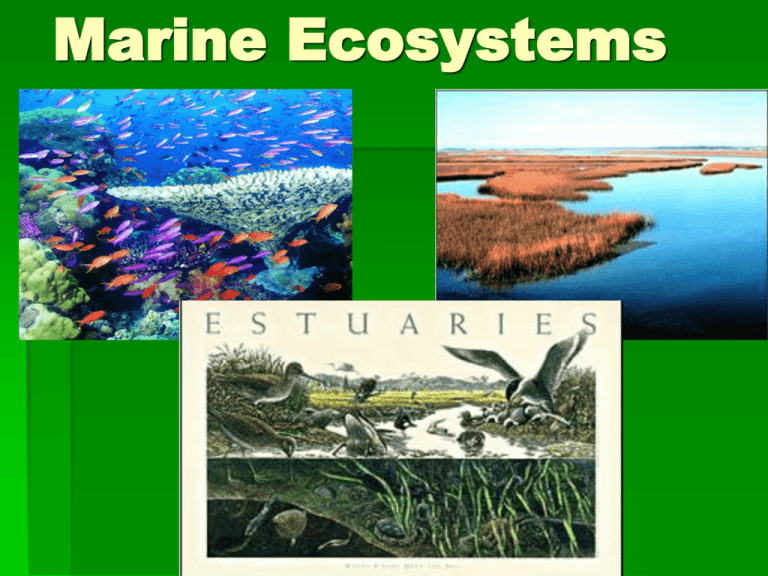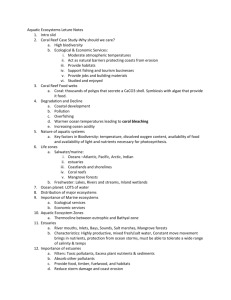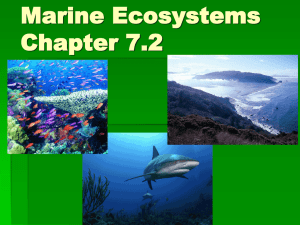Marine Ecosystems
advertisement

Marine Ecosystems Ocean coasts support plant and animal life Habitat – an environment that has all necessary requirements for an organism to live. Intertidal Zone – the habitat at the edge of the ocean. Estuaries – the place where fresh water from rivers and streams mixes with salt water from the ocean. Wetlands – wet, swampy areas that are often flooded at the edge of estuaries. ECOLOGICAL ADVANTAGES Climate moderation CO2 absorption Nutrient cycling Waste treatment and dilution Reduced storm impact (mangrove, barrier islands, coastal wetlands) Habitats and nursery areas for marine and terrestrial species Genetic resources and biodiversity Scientific information ECONOMIC ADVANTAGES Food Animal and pet feed (fish meal) Pharmaceuticals Harbors and transportation routes Coastal habitats for humans Recreation Employment Offshore oil and natural gas Minerals Building materials Types of Marine Ecosystems Estuaries Salt marshes Rocky shores Sandy Shores Coral reef Mangrove swamp Barrier islands Estuaries An area in which fresh water from a river mixes with salt water from the ocean; a transition area from the land to the ocean. Other names: bay, sound, lagoon, harbor, or bayou. The Ocean Area where fresh and salt water mix River bringing freshwater to the sea Characteristics of Estuaries Water is brackish : a mixture of freshwater and saltwater There is a gradual increase in salinity as you go from the river (0-5ppt) to the middle of the estuary (5-25ppt), to the ocean (>25 ppt). (ppt = parts per thousand, a unit for salinity) Pollutants are absorbed in estuaries. Characteristics of Estuaries Very nutrient rich ecosystems leads to high productivity and high biodiversity. Fast-moving rivers and waves carry nutrientrich particles. Sediment settles out in the estuary when the water slows down. Nutrients accumulates on the bottom (benthic zone). Great place for plants to grow! Estuary plants Plants must be adapted to salty habitat eelgrass cordgrass glasswort – a succulent Estuary animals Huge variety including… Blue crab, Stone crab, Fiddler crab, Horseshoe crab, Mosquito, Lobster, Flounder, Stripped bass, Crane, Flamingo, Sea gull, Ibis, Manatee, otters, and many more. Salt Marshes A low area that is subject to regular, but gentle, tides, dominated by grasses. Salt marshes do not have trees or shrubs Location: Gulf of Mexico and Atlantic coast Texas salt marsh Mangrove Swamps Coastal wetlands located in tropical and subtropical zones; characterized by salt-tolerant trees and shrubs, such as mangrove trees Rocky shores Also called rocky intertidal zone – many places to live in this habitat, means high biodiversity Organisms must be adapted to wave action, changing tide levels Rocky Shores At low tides, there are often tide pools left behind where you can see starfish, anemones, crabs, octopus Sandy Shores Not as much biodiversity as rocky shores – Why? 1. not much habitat diversity 2. sand dries out at low tide some small things can live in the sand, food for shorebirds Barrier Islands Narrow islands made of sand that provide a buffer for the mainland from the sea Constantly shifting, especially with storms Ex: North Carolina OuterBanks Barrier beach Beach flea Peanut worm Tiger beetle Blue crab Clam Dwarf olive High tide Sandpiper Silversides Mole shrimp Low tide White sand macoma Sand dollar Moon snail Ghost shrimp Barrier Islands Ocean Beach Primary Dune Intensive recreation, no building Trough Secondary Dune No direct Limited passage recreation or building and walkways Grasses or shrubs No direct passage or building Taller shrubs Back Dune Bay or Lagoon Most suitable for development Intensive recreation Bay shore No filling Taller shrubs and trees Think about ecological succession as you move away from the ocean. What is the “disturbance” in this ecosystem? Coral Reefs Structures in the shallow oceans that are built by animals called corals; serve as a habitat for many diverse organisms Require two things: warm temperatures and sunlight Found between 30°N and 30°S of the equator Coral Reefs There are many different kinds of corals: Soft corals Hard corals Coral Reefs Growing on the reef with the corals are other animals, such as sponges, worms, shrimps, crabs, mollusks Living in and around the reef are fish, sea turtles, sea snakes, marine mammals Coral Reef Destruction 1. Coral bleaching – when temperatures go above normal, the algae in the coral can be rejected, the coral turns a whitish color and dies. Natural and/or manmade causes: El Nino, Global warming Coral Reef Destruction 2. Physical damage Ships, anchors, tourist divers Dynamite fishing - reefs are damaged by physical destruction that may occur when people collect fish Coral Reef Destruction 3. Land development and pollution – loss of mangrove forests means more nutrients and sediments flow out to the sea; coral may die from sediment or algal blooms 4. Fish and coral trade 5. Increased exposure to UV due to ozone depletion Human Interactions Effect Shorelines Half of coastal wetlands lost to agriculture and urban development Over one-third of mangrove forests lost since 1980 to agriculture, development, and aquaculture shrimp farms About 10% of world’s beaches eroding because of coastal development and rising sea level Ocean bottom habitats degraded by dredging and trawler fishing boats Human Interactions Effect Shorelines Over 25% of coral reefs severely damaged and 11% have been destroyed UPWELLING Winds blowing across the ocean surface push water away. Water then rises up from beneath the surface to replace the water that was pushed away.






